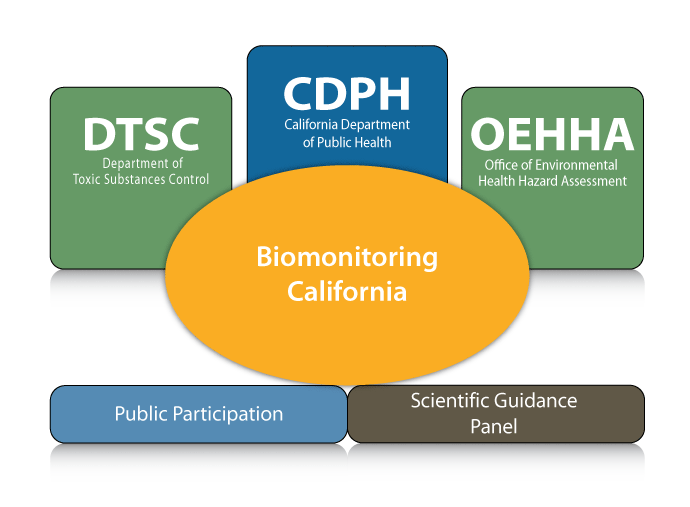 Multi-Agency Program
Multi-Agency Program
The California Environmental Contaminant Biomonitoring Program (also known as Biomonitoring California) is a collaborative effort of three departments in two State agencies:
- The California Department of Public Health (CDPH) www.cdph.ca.gov in the Health and Human Services Agency. CDPH is the lead department for Biomonitoring California.
- California Environmental Protection Agency’s (Cal/EPA's) Office of Environmental Health Hazard Assessment (OEHHA) www.oehha.ca.gov and Department of Toxic Substances Control (DTSC). www.dtsc.ca.gov
Key Findings
See highlights of key findings from our collaborative projects on the Program Accomplishments page.
Created by Legislation Passed in 2006
Biomonitoring California was established by Senate Bill 1379, authored by Senator Don Perata and Senator Deborah Ortiz, which was passed by the California Legislature and signed into law by Governor Schwarzenegger in 2006.
Public Involvement
Biomonitoring California involves interested members of the public throughout the state in the process of developing and carrying out the program. Visit the Public Involvement page to find out how you can participate. To contact us, send email to biomonitoring@oehha.ca.gov .
Scientific Guidance Panel
A panel of experts, the Scientific Guidance Panel (SGP), makes recommendations regarding the Program's design and implementation. The SGP will make specific recommendations regarding chemicals that are priorities for biomonitoring in California and provide scientific peer review for Biomonitoring California.
Role of the federal Centers for Disease Control and Prevention
The federal Centers for Disease Control and Prevention (CDC) conducts the National Biomonitoring Program. CDC also provides funding to state biomonitoring programs. Biomonitoring California received funding from CDC from 2009 to 2014 (Grant Number U38EH000481) and was awarded a second grant for 2014 to 2019 (Grant Number U88EH001148). Funding from CDC supports laboratory activities, field work (such as sample collection), return of results to participants, and improvements to the website.
CDC subject matter experts provide technical assistance and consultation to Biomonitoring California in the areas of sampling strategy, data collection methods, and data management systems. CDC laboratory staff also share chemical analysis methods with state laboratories and train state laboratory staff. This support helps Biomonitoring California develop rigorous protocols to ensure that blood, urine, and other biological specimens are tested in the most accurate and valid manner.
Biomonitoring California Laboratories
Biomonitoring California laboratories have extensive experience analyzing biological specimens (such as blood and urine) for chemical contaminants. Examples of chemicals the laboratories are capable of analyzing include metals (e.g., mercury, lead, cadmium), pesticides, phenols (e.g., bisphenol A, triclosan), phthalates, polycyclic aromatic hydrocarbons (PAHs), perfluorinated chemicals, and polybrominated diphenyl ethers (PBDEs).
Biomonitoring California collaborates on laboratory analyses with researchers who have collected urine or blood specimens from California residents. Periodically the Program has issued Requests for Information (RFIs) to identify researchers who are interested in working with Biomonitoring California and who meet the RFI submission guidelines. No RFI is currently underway. To view the 2011-2012 RFI application, please follow this link: Biomonitoring_RFI.pdf


